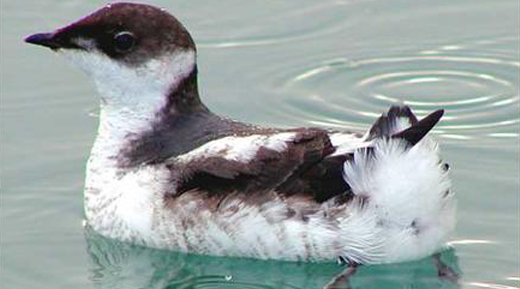Connections, Murrelets, and Global Change
 “The implications of study of many ecological artifacts are becoming more and more obvious in their indictment of climatic change,” explains H.H. “Hank” Shugart. Shugart is the W.W. Corcoran Professor of Natural History in the Department of Environmental Sciences in the College and Graduate School of Arts & Sciences at the University of Virginia.
“The implications of study of many ecological artifacts are becoming more and more obvious in their indictment of climatic change,” explains H.H. “Hank” Shugart. Shugart is the W.W. Corcoran Professor of Natural History in the Department of Environmental Sciences in the College and Graduate School of Arts & Sciences at the University of Virginia.
Six years ago, Duane Osheim and I were reprising a great day in a Costa Rican rainforest spent enthusiastically seeing its matrix of ecological marvels. Duane, professor emeritus in UVA’s Corcoran Department of History, opined that ecologists—me for example—saw elements of nature much as a historian might see an artifact or a historical document. The study of artifacts has a power to reveal the connectedness and internal workings of the cultural networks in history. Ecologists contemplate their own ecological “artifacts,” such as species derived through evolution, and their interaction with the environment to apprehend ecosystem structure and dynamics.

Last year from the deck of the small cruise ship, Le Soléal,[1] I watched marbled murrelets pop out of the waters of the Alaskan Inside Passage, fly a few yards, and then dive again for food. These are wonderful creatures from the front pages of most bird books. There, they are pictured along with their taxonomic cousins in the family Alcidae or Alcids — including other small murrelets and auklets, and larger auks, murres, guillemots, and puffins. Alcids are black and white saltwater divers of northern rocky coasts — flying analogues to the flightless penguins of the Southern Hemisphere. Marbled murrelets are stocky little birds about 10 inches from beak to tail. They swim by “flying in the water” with flipper-like wings and can dive as deeply as 300 feet. In flight, they look a bit like large bumblebees with their buzzing short wings propelling their pudgy bodies. As a boy birdwatcher growing up in the South, they were the exotic birds that I never would see. Yet, there they were feeding in the cold ocean waters; they were a wonder before my eyes.

Marbled murrelets are also a disappearing ecological artifact. They are an endangered species with declining populations. Initially, no one really knew where these creatures nested. We now know that unlike any related Alcids, marbled murrelets nest in trees. A single egg is laid in a nest on the mossy limbs of large conifer trees of the old-growth forests of the Pacific fjordlands. A fledgling’s first flight is directly to the sea. Marbled murrelet decline results from the loss of the nesting habitat of the birds. As I watched the murrelets feed, in the background were hillsides of dying or dead older trees. Death had come from insect epidemics killing trees already weakened by changes in climate. Along with the disappearing nest sites for murrelets and the destruction of the grand ecosystem that they inhabit, the air had the whiff of smoke from fires burning far away in Anchorage, also a climate-change-driven phenomenon. It was beautiful, but a terror to behold. Sadly, such changes are all around us. The implications of study of many ecological artifacts are becoming more and more obvious in their indictment of climatic change.

This morning’s Washington Post[2] brought news of the beginning of a very early and very intense wildfire season in Siberia. Ecologists, including my own graduate students, have predicted since the 1980s that climate change should produce such early intense fires in Russia. My students and others have seen this intensification over the past four decades using satellite imagery. It is cold comfort to see dire predictions develop as predicted, particularly since what should happen next should be even more disastrous.
[1] University of Virginia Alumni Travel Program: Alaska ~ Glaciers and the Inside Passage, July 6-13, 2019
[2] July 4, 2020.
- A Revolution in the Air: The Wright Brothers Take to the Sky on December 17, 1903
- Musings on National Violin Day
- Making the Promise Real: How a UN Tax Convention Can Fulfill the UNDHR’s Vision
- UVA Club of Atlanta: Virtual Pilates Class
- UVA Club of Houston: Hoo-liday Party
- UVA Club of Fredericksburg: Hoo-liday Lights Tour